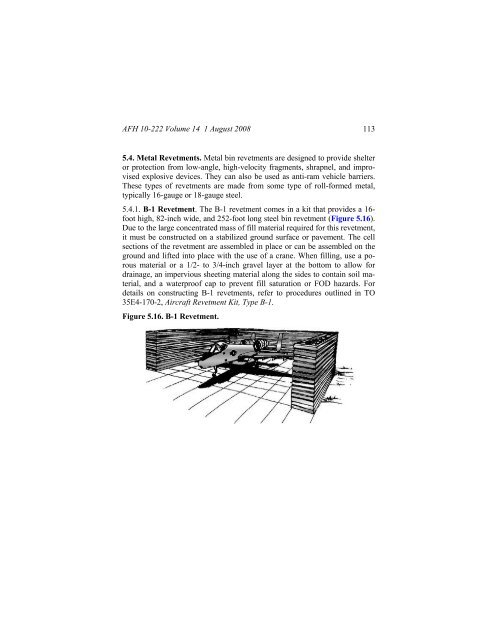Civil engineer guide to fighting positions, shelters, obstacles
Civil engineer guide to fighting positions, shelters, obstacles
Civil engineer guide to fighting positions, shelters, obstacles
You also want an ePaper? Increase the reach of your titles
YUMPU automatically turns print PDFs into web optimized ePapers that Google loves.
AFH 10-222 Volume 14 1 August 2008 113<br />
5.4. Metal Revetments. Metal bin revetments are designed <strong>to</strong> provide shelter<br />
or protection from low-angle, high-velocity fragments, shrapnel, and improvised<br />
explosive devices. They can also be used as anti-ram vehicle barriers.<br />
These types of revetments are made from some type of roll-formed metal,<br />
typically 16-gauge or 18-gauge steel.<br />
5.4.1. B-1 Revetment. The B-1 revetment comes in a kit that provides a 16foot<br />
high, 82-inch wide, and 252-foot long steel bin revetment (Figure 5.16).<br />
Due <strong>to</strong> the large concentrated mass of fill material required for this revetment,<br />
it must be constructed on a stabilized ground surface or pavement. The cell<br />
sections of the revetment are assembled in place or can be assembled on the<br />
ground and lifted in<strong>to</strong> place with the use of a crane. When filling, use a porous<br />
material or a 1/2- <strong>to</strong> 3/4-inch gravel layer at the bot<strong>to</strong>m <strong>to</strong> allow for<br />
drainage, an impervious sheeting material along the sides <strong>to</strong> contain soil material,<br />
and a waterproof cap <strong>to</strong> prevent fill saturation or FOD hazards. For<br />
details on constructing B-1 revetments, refer <strong>to</strong> procedures outlined in TO<br />
35E4-170-2, Aircraft Revetment Kit, Type B-1.<br />
Figure 5.16. B-1 Revetment.
















